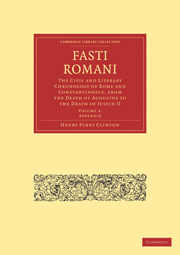 Fasti Romani
Fasti Romani Summary
THE years of the Roman emperors and the fractions of months and days are carefully noted by Dio and other historians. But yet even if the genuine numbers were always preserved, which is not to be expected, the sum of all the reigns would not express the exact amount of time; for sometimes the reigns are in part contemporary; as the last 4 months of Justin were also the first 4 months of Justinian; the last 10 days of Justin II were the first 10 of Tiberius II; the two last days of the same Tiberius were the first two of Mauricius. Galba Otho and Vitellius were in part contemporary with Nero and Vespasian. The elder Gordians Pupienus and Balbinus were included for the most part in the reign of Maximin. The last day of an emperor was sometimes counted again as the first of his successor; thus Aug. 19 A. D. 14 was both the last day of Augustus and the first of Tiberius. Sometimes a short interval occurred; as 10 days after the death of Jovian; 3 days at the least after the death of Trajan; a day between Caligula and Claudius, called by Suetonius two days (current) of liberty. Sometimes the life or reign of an emperor was reckoned exclusive of the day of his death; as the life of Caracalla by Dio, and the reign of Heraclius by Nicephorus.
But on the other hand the chronographers give erroneous accounts because they often omit fractions of years that they may obtain a more convenient measure of time.
- Type
- Chapter
- Information
- Fasti RomaniThe Civil and Literary Chronology of Rome and Constantinople, from the Death of Augustus to the Death of Justin II, pp. 1 - 179Publisher: Cambridge University PressPrint publication year: 2010First published in: 1850
